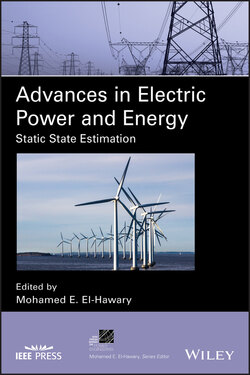Читать книгу Advances in Electric Power and Energy - Группа авторов - Страница 44
2.3.2 Identification of Erroneous Measurements
ОглавлениеIf the bad measurement test detects bad measurements, these measurements should be identified. This is accomplished below.
Consider the nonlinear measurement model
(2.14)
where xtrue is the unknown true state vector and e is the measurement error vector. Note that
(2.15)
which is a typical assumption in state estimation.
Consider the differential measurement equation:
(2.16)
If measurements are Gaussian distributed and independent, the least squares estimator can be obtained by minimizing the weighted sum of square deviations of the differential errors:
(2.17)
This minimization problem leads to the system of equations:
(2.18)
known as the system of normal equations [8]. Assuming that the gain matrix
(2.19)
has an inverse, the least squares estimates can be written explicitly as
(2.20)
from which we conclude that is a linear function of dz.
The residual and the differential residual are defined as
(2.21)
(2.22)
Thus
(2.23)
where P = HG−1HTW is known as hat or projection matrix.
Integrating (2.23), the linear transformation from z to r at the optimum is
(2.24)
where k is a constant vector and S is known as the residual sensitivity matrix.
If measurements z are Gaussian distributed and independent with zero mean and covariance matrix R (R = W−1) and is an unbiased estimator of h(xtrue), i.e. , the residual vector r provided by the linear transformation (2.24) is Gaussian distributed with parameters given by
(2.25)
(2.26)
and due to (2.14) and (2.25):
(2.27)
The normalized residual (N(0, 12)) of measurement i is
(2.28)
The largest residual identifies a bad measurement with a 1 − α confidence level (e.g. 0.99) if . Further details can be found in [7].
